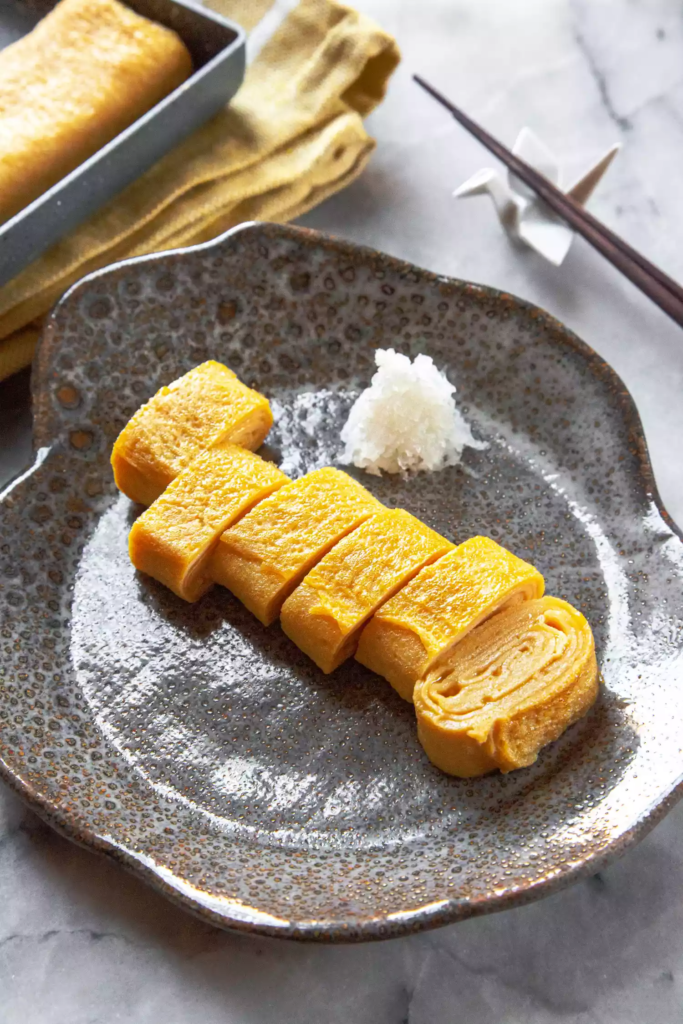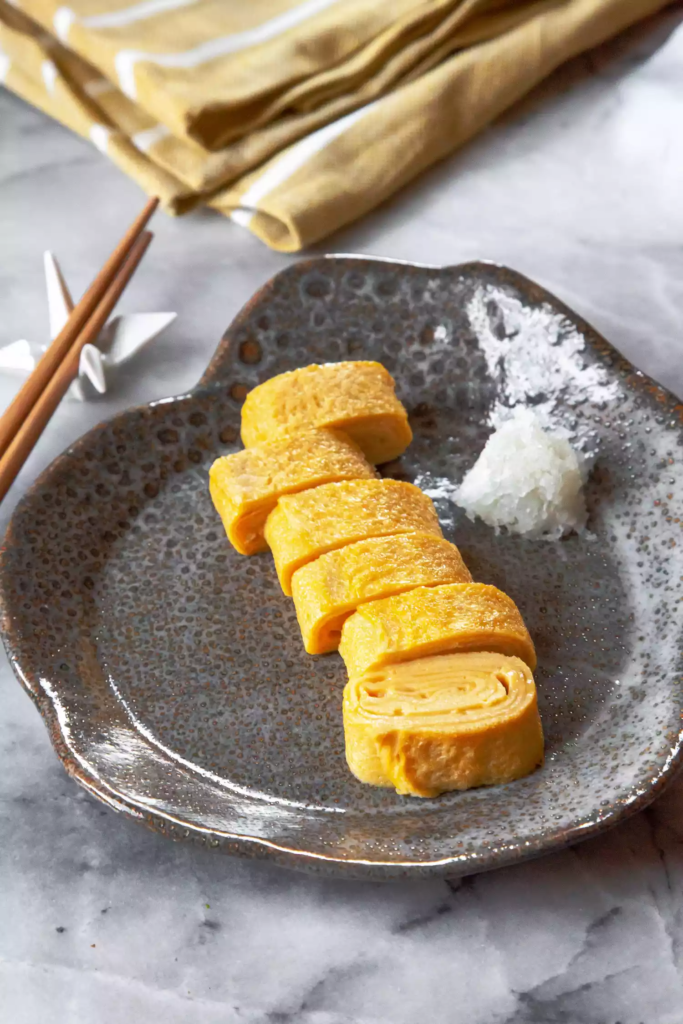Tamagoyaki

Tamagoyaki is a soft and delicate rolled omelet and a classic Japanese dish. The technique to flip and roll the eggs may look tricky, but if I can do it, you can too!
- Total Time: 20 minutes
Description
When I spent a month in Japan post-college, I was absolutely obsessed with bento box lunches. Tamago sushi was a common side dish found in them. These slightly sweet, rich, and creamy rolled eggs, sliced to reveal a beautiful swirl inside, were placed on a rectangular bed of sushi rice and wrapped with a strip of nori.
Years later, I learned to make that same Japanese egg omelet, called tamagoyaki, without the rice and nori. Even though I’m not an expert in Japanese cuisine, I set out to make it at home and I’m here to share what I’ve learned with you!
Tamagoyaki is an easy breakfast or a great side dish for lunch or dinner. Best of all, leftovers are amazing, cold from the fridge or warmed up in the microwave. That’s why I always make extra.
Tamagoyaki is a rolled egg omelet, slightly sweetened with sugar and seasoned with soy sauce, mirin, and dashi. Tamago means “egg” and yaki means “grill” in Japanese.
There are many variations of tamagoyaki in Japan depending on the region. Some simply season it with salt, soy sauce, and sugar. Others add mirin and dashi stock. Some add fillings like seaweed, salmon, or cheese.
This recipe is for a dashimaki tamagoyaki, which has mirin and dashi, an umami-rich stock made with kombu and bonito flakes. I cheat and use an instant dashi powder called Hondashi. It’s not as complex or deep in flavor as traditional dashi stock, but that’s okay for this recipe. Find it at any Japanese grocery store, well-stocked Asian market, or online.
In Japan, tamagoyaki is made so often that a specific pan called a kotobuki tamagoyaki is used. It is a long rectangular pan with curved sides, which makes flipping, rolling, and sliding the egg much easier.
To be honest, you don’t need a kotobuki tamagoyaki. Any small nonstick frying pan will work. But if you do find yourself falling in love with tamagoyaki and want to make it often, you can easily find one for $15 to $20.
Ingredients
- 1/4 cup warm water
- 1/4 teaspoon instant dashi powder, like Ajinomoto Hondashi
- 4 large eggs
- 2 teaspoons sugar
- 1/2 teaspoon kosher salt
- 1 teaspoon soy sauce
- 1 teaspoon mirin
- 1 tablespoon canola oil
- Grated daikon, for serving (optional)
Instructions
In a small bowl or glass measuring cup, combine the 1/4 cup warm water and dashi powder. Mix with a fork until the granules dissolve. The warm water simply helps them dissolve, so don’t stress if you use room temperature or cold water.
In a medium bowl, add the eggs, sugar, and salt. Use a fork to beat the eggs until thoroughly combined. Try not to incorporate too many bubbles.
Add the dashi stock, soy sauce, and mirin. Mix until the ingredients are incorporated.
For a silkier custard-like texture, strain the eggs through a fine mesh strainer set over a liquid measuring cup with the spout—it will make pouring the egg batter into the pan easier.
Place the oil in a small bowl and dip a small, folded paper towel into it. Use the saturated paper towel to wipe the inside of a kotobuki tamagoyaki or small nonstick pan. Heat the skillet over medium heat, enough to immediately start cooking the eggs when they are added but not so hot that they brown right away, then reduce the heat to medium-low.
Pour a small amount of batter into the pan, just enough to fully coat the bottom. Cook until it is mostly set, with the top still slightly liquidy.
Use chopsticks or a thin fish spatula to lift one end, flipping and rolling it over to the opposite end of the pan. Don’t worry if the first couple of flips are wrinkled or scrunched up. Just keep on rolling with it.
Use the oil-saturated paper towel to wipe the skillet with more oil, lifting the cooked egg up to get some oil under it. Then pour more egg batter in, just enough to coat the bottom of the pan. Lift the cooked egg up slightly and tilt the pan so the egg batter can get under it.
Cook until it’s mostly set. Roll the eggs again the opposite direction, building up layers, sort of like building a snowman. Repeat this process one more time, oiling the pan, adding more egg batter, and rolling it back the other way. You will have used half the egg batter at this point.
Slide the tamagoyaki onto a serving plate or a cutting board.
Make a second tamagoyaki with the remaining batter following the same process.
Cut the tamagoyaki into 1-inch slices to reveal the swirls inside. Serve with grated daikon radish on the side, if you’d like, or as part of a larger Japanese-inspired meal.
Leftovers can be refrigerated for 3 or 4 days. Though you can serve it cold, I like to remove it from the fridge and let it sit on the counter for 30 minutes or so to take the chill off. You can also heat it up briefly in the microwave in 15-second bursts until warmed through.
- Prep Time: 10 mins
- Cook Time: 10 mins


